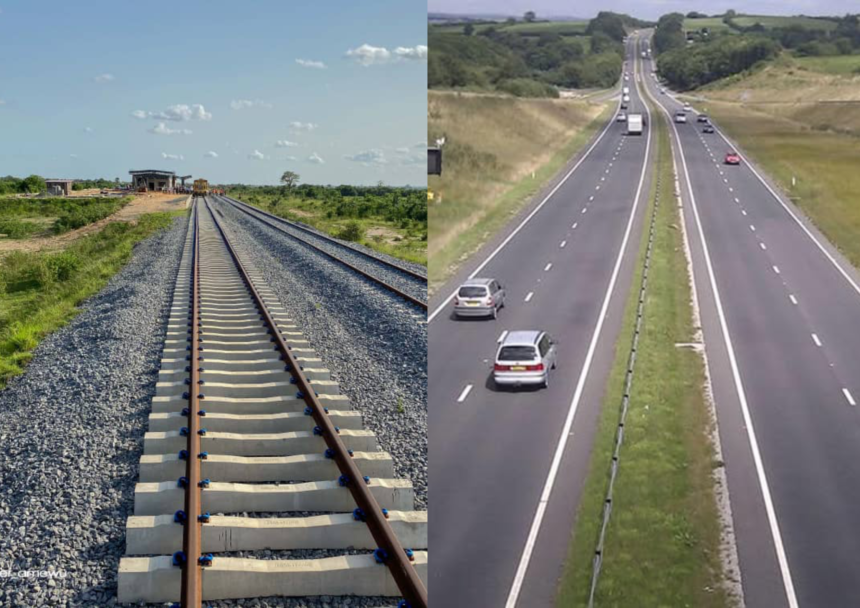While government communicators are out there selling glossy images of a new Accra–Kumasi Expressway to the public, pretending this is the biggest national breakthrough in decades, the real question we must ask is this: Is another road what Ghana truly needs, or are we once again chasing votes at the expense of vision?
Because if this is about solving transport bottlenecks and unlocking trade potential between Accra and Kumasi, then we are backing the wrong horse. Ghana needs a proper, modern, standard-gauge railway—not just another high-speed highway that will be congested within five years and littered with crash victims.
Let’s be honest. Roads move cars. Railways move economies.
The Numbers Don’t Lie—They Shame Us
According to the International Energy Agency (IEA), railways are over three times more energy-efficient than trucks for freight. Meanwhile, trains emit far less carbon into the atmosphere. At a time when Ghana spends a significant chunk of its foreign exchange on petroleum imports, why are we still addicted to asphalt?
It gets worse. As per the National Road Safety Authority (NRSA), between January and September 2024 alone, Ghana recorded 9,820 road crashes, 1,817 deaths, and 11,408 injuries. A significant portion of these accidents happened on major corridors like the Accra–Kumasi highway—the same corridor we are now about to widen with taxpayers’ money, instead of relieving it with rail. And the government knows this. They just won’t act on it.
Roads Get Billions, Rails Get Crumbs—Why?
For years, our budgets have thrown billions at roads. Railway development? Mere tokenism. Take this: a single modern freight train can carry the load of over 300 articulated trucks. Imagine what that could mean for road maintenance, fuel savings, and traffic reduction. Yet somehow, rail continues to be treated like a side project. The result? We build highways that end up looking like car parks during holidays, while our railways rot or remain half-finished.
What Abuja and Pretoria Know That Accra Refuses to Learn
Look elsewhere on the continent and Ghana’s inertia becomes embarrassing. Nigeria built the Abuja–Kaduna Standard Gauge Railway (187 km) with help from the China Exim Bank. It slashed travel time from over five hours by road to under two hours by rail. It also provided a safe alternative to a highway plagued by armed attacks. South Africa’s Gautrain has transformed urban mobility and become a flagship example of PPP-driven infrastructure success. And what is Ghana doing? Celebrating the Tema–Mpakadan Railway like it’s a global first—when in fact, it’s only 97 km long, took years to complete, and doesn’t even connect to Kumasi or Boankra, the real game changers.
Boankra Inland Port—A Future Dead on Arrival?
Ghanaians have heard about the Boankra Inland Port for years. The $330 million project, now under construction, is supposed to relieve pressure on Tema and Takoradi by serving as a dry port hub. But here’s the catch: no rail link means no real impact. The Ghana Ports and Harbours Authority has warned that without rail, the port’s potential will collapse under high transport costs, long turnaround times, and underutilization. In short, it’s another beautiful building with no backbone. The concessionaire says Phase 1 will be ready in 2025. But ready for what? More trucks? More gridlock?
So What’s the Excuse? “It’s Too Expensive”? Please.
Yes, rail costs money. But so does everything else that works. According to the Ghana Railway Development Authority’s (GRDA) master plan, the full network (over 4,000 km) will cost about $21.5 billion. The Accra–Kumasi leg alone would be in the billions. But is this impossible? Not at all. Nigeria got a concessional loan from China Exim. Ghana too can tap into AfDB and World Bank transport windows, leverage AfCFTA-linked sovereign bonds, and attract private players through well-structured concessions like Ethiopia’s Ethio-Djibouti Railway. What’s lacking? Political boldness and clear legal frameworks to de-risk the project.
Rail Means Jobs, Not Just Trains
A railway is not just about transport—it’s a jobs engine. According to GRDA estimates, a modern rail project would directly and indirectly generate employment in engineering, track maintenance, rolling stock assembly, logistics, warehousing, retail, and services around interchanges. Communities from Nsawam to Konongo could see an economic transformation. That’s real impact—not just pothole-patching optics.
So Why Are We Still Hooked on Roads?
Because roads can be started and finished within four years—just in time for ribbon-cutting before elections. Rail? It requires long-term thinking and project continuity. Unfortunately, the Ministry of Railways has been dissolved, reshuffled, and neglected so often, it’s hard to know who’s in charge of what. That’s why roads win. Not because they’re better—but because they’re politically convenient.
Conclusion: Ghana Must Decide—Optics or Outcomes?
The evidence is overwhelming. The logic is sound. The examples are numerous. So why is the Accra–Kumasi Expressway being treated as a national miracle, while a railway that could transform Ghana’s logistics future is ignored?
This isn’t about whether Ghana can afford a modern railway. It’s about whether Ghana can afford to keep pretending we don’t need one. Boankra will falter. Emissions will rise. Our roads will bleed more lives and more money. And our logistics sector will remain painfully inefficient.
Let’s call a spade a spade. Roads may win elections. But rail wins the future.




